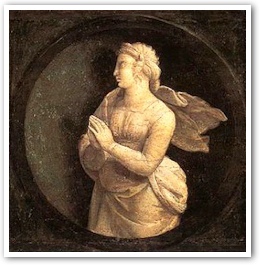The Death of Jesus
- FR. KENNETH BAKER, S.J.
In the Nicene Creed we profess that jesus died and was buried. These are the final affirmations in the Creed about the earthly life of the Savior of mankind.
 |
All men are under the certain sad sentnce of death. Death, as we know from Romans 5 and 6, is the consequence of sin. "The wages of sin is death," writes St. Paul (Rom 6:23). When God first created man, he did not destine him for death (cf. Gen 2-3). The official doctrine of the Church on this truth was spelled out in detail by the Council of Trent.
Philosophically, death means the separation of the soul from the body. There is both a personal and an impersonal dimension to the meaning of death. On the impersonal plane, it means that biological and physical forces overpower man to such an extent that his soul can no longer animate the body. The signs of death are the cessation of biological functions and the beginning of corruption.
On a personal plane, death means that our spiritual growth and our exercise of human freedom in time come to a brutal halt. As adults, we determine ourselves according to our likes and dislikes, our aspirations and our fears. In death, we are determined by powers beyond our control and contrary to our will.
Man lives his whole life under the shadow of death. It is our constant companion, whether we explicitly advert to it at each moment or not. Man fears death and senses, somehow, that it should not be, that it is beneath his diginity to have to submit to physical dissolution.
The above is a very brief sketch of death. The point here is that jesus Christ, the sinless One, submitted to the power of death which had no right to claim him. He dies our death in order to save us from eternal death and open up to us the life of God. Thus St. Peter says: "Christ also died once for our sins, the just for the unjust, that he might offer us to God, being put to death indeed in the flesh, by enlivened in the spirit" (1 Pet 3:18).
The death of Jesus was a true death, not just an apparent one. This means that when "he cried out with a loud voice" (Mt 27:50) on the cross and gave up his spirit to God, his human soul, which is of the same nature as our souls, left his torn and bloody body.
In the Apostles' Creed, which we traditionally pray at the beginning of the Rosary, we add after the death and burial of Jesus that "He descended into hell." This expression is not included in the Nicene Creed, but it means that the soul of Jesus was truly separated from his body, that he was dead, and that his pure soul entered into the realm of the dead called by the Jews Sheol or the "underworld". It does not mean that he was punished in hell in the usual Christian sense of the place and state of eternal torment. It was the obedient death of Jesus that threw open the gates of heaven. Thus, according to Catholic belief, in the period after his death and before his Resurrection, he set free all the saved who were detained in Sheol from the time of Adam to Calvary.
Christ died. After his death he was buried according to the Jewish custom. In this he also shared our lot, with the exception that his body was not to see corruption. This is in accordance with Psalm 16 (10): "You will not give your holy one to see corruption." According to St. Thomas, the reason for this is that although Christ's body was formed from earthly matter as ours is, its formation was not by any human power but by the power of the Holy Spirit. Hence he did not wish the body that had been formed by the Holy Spirit to undergo dissolution, since this respect he was different from other men.
See the index of chapters from Fundamentals of Catholicism which have been reprinted to CERC here.
 This is Meaghen Gonzalez, Editor of CERC. I hope you appreciated this piece. We curate these articles especially for believers like you.
This is Meaghen Gonzalez, Editor of CERC. I hope you appreciated this piece. We curate these articles especially for believers like you.
Please show your appreciation by making a $3 donation. CERC is entirely reader supported.

Acknowledgement
Kenneth Baker, S.J. "The Death of Jesus." In Fundamentals of Catholicism Vol. 1 Chapter 21 (San Francisco: Ignatius Press, 1995), 67-69.
This article reprinted with permission from Father Kenneth Baker, S.J.
The Author

 Father Kenneth Baker, S.J., assumed editorship of Homiletic & Pastoral Review in April 1971 and remained in this position for almost forty years. In 1983 he published a three-volume explanation of the faith called Fundamentals of Catholicism Vol. 1, Creed and Commandments; Vol. 2, God, Trinity, Creation, Christ, Mary; and Vol. 3, Grace, the Church, the Sacraments, Eschatology
Father Kenneth Baker, S.J., assumed editorship of Homiletic & Pastoral Review in April 1971 and remained in this position for almost forty years. In 1983 he published a three-volume explanation of the faith called Fundamentals of Catholicism Vol. 1, Creed and Commandments; Vol. 2, God, Trinity, Creation, Christ, Mary; and Vol. 3, Grace, the Church, the Sacraments, Eschatology


